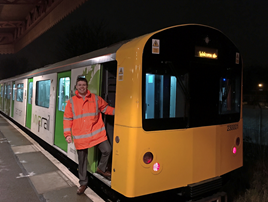2017 promises to be a happy new year indeed for Vivarail, as its innovative project to turn former London Underground D-Stock trains into diesel electric multiple units takes a huge leap forward.
That’s because, as this issue of RAIL went to press, Vivarail’s first fully converted D-Train was due to receive its final safety certification, clearing the way for it to enter passenger service with the company’s first customer (London Midland on the Coventry-Nuneaton line) in February.
It marks the end of a long and gruelling testing and commissioning phase that began back in January 2015, following the delivery of the first batch of the 220 redundant ex-District Line vehicles acquired by Vivarail from LU.
Entry into traffic of the first D-Train (known by its TOPS classification as a Class 230) comes a full 12 months later than Vivarail’s self-imposed deadline of early 2016 that its engineers were still confident of meeting back in September 2015, when RAIL reported on progress following a visit to the company’s workshop at Long Marston (RAIL 782).
It was there that the first three-car prototype (230001) was being assembled and refurbished, comprising two driving cars and one trailer car. But it was then that the conversion project started to become unstuck and dogged by delays, as the technical complexity of building a new train from withdrawn D78 Tube stock became increasingly apparent.
Vivarail missed its timetabled testing dates on the Cotswolds line at Evesham in November 2015, as the technical team also had to contend with shifting testing criteria after several alterations were made by the Office of Rail and Road (ORR) midway through production.
The task of creating a new class of train was also (and perhaps unsurprisingly) found to be particularly demanding for a small company with barely 20 people on its books, and which has been trying to make headway in an established marketplace shared with the muscular presence of several large international competitors.
But all that can now be put behind them, says Vivarail Chairman Adrian Shooter, now that it has succeeded in turning out the finished article.
“It’s important to remember that apart from the bodyshells and the bogies, these are completely new trains,” he tells RAIL.
“We’ve had a slow start going from designing and rebuilding one train to standing on the verge of serious production of a reasonable amount of trains, as we needed all sorts of systems and processes in place.
“We’ve had absolutely no public money to develop this, so we’ve had to watch the pennies. We are also a small company and this has turned out to cost more than we thought, but at the end of the day it’s far more important that it’s right than it’s rushed.
“Several hundred standards have had to be met for ORR, and we’ve had to do exactly the same as Hitachi or Siemens would have to do when introducing a new train. But we have done, in less than two years, what much larger manufacturers often take twice as long to do.”
At the time of RAIL’s most recent visit to Vivarail on December 9, the test train 230001 was being stabled at Tyseley Locomotive Works, having arrived on November 28 for main line testing and mileage accumulation. Vivarail needed to move the prototype to this temporary home for additional testing because only a limited amount could be completed at Long Marston - line speeds on its 2½-mile home test track are limited to 45mph (15mph below the D-Train’s top speed).
On December 12 and 13 the train was run as a two-car and then a three-car unit, unloaded at first and then loaded with 15 tonnes of weights to simulate braking conditions when conveying passengers. To perform this task, 230001 was operated by West Coast Railways on Vivarail’s behalf, to and from Leamington Spa station.
Having undergone these final tests, the train was then taken to Nuneaton, where it remained for the duration of the festive period before the start of driver training with London Midland.
Provided certification is received this month (January) as expected, 230001 will be operated by London Midland from late February onwards between Nuneaton and Coventry, in a trial funded by West Midlands Combined Authority, and which includes partner organisations Coventry City Council, Warwickshire County Council and London Midland. The trial will last for eight months until October 14, when the current London Midland franchise expires.
This short commuter route was intentionally chosen to best demonstrate the Class 230s’ virtues as a high-capacity, lower-cost and more quickly-produced alternative to the procurement of new DMUs. Before its arrival, the only stock available to LM was a single-car Class 153 that was hopelessly inadequate for serving the newly opened station at Coventry (Ricoh) Arena and for coping with the events frequently hosted there.
















Login to comment
Comments
No comments have been made yet.